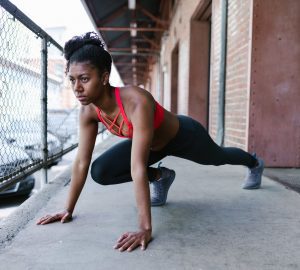When attempting to increase muscle size many people get stuck in the same old boring methods of 3-4 sets of 8-12 reps. Although this is great and can definitely increase muscle size, as a lifter becomes more advanced it can become a bit stale. That is why it is important to experiment with different techniques in your routine to keep it fresh, and to most importantly keep the gains coming. A few amazing muscle building techniques that are commonly used are drop sets, isometric holds, heavy eccentrics and cluster sets. Include one or multiple of these techniques in your next lifting session and you are sure to feel the pain.
Drop Sets
Drop Sets are a technique where you complete a set to; or close to, failure, and then drop the weight being used and complete more repetitions. This is an amazing technique to add towards the end of your workout, or for the last set of a given exercise. By reducing the weight it allows the individual to complete more repetitions and actually go beyond what would normally be failure. This type of training also has the potential to increase the number of muscle fibers activated. By starting with a heavy weight in a more hypertrophic range, the more powerful and easily fatigued fast-twitch muscle fibers can be exhausted. As the weight is dropped and additional repetitions are completed, some of the longer lasting slow twitch muscle fibers are recruited. This method of training is better suited for single joint, or isolation exercises, such as bicep curls and tricep pushdowns, or even leg extensions. It is not recommended to do this method for compound motions like the squat, due to the importance of maintained form in injury prevention.
Isometric Drop Sets
If drop sets aren’t hard enough you can add a little extra to really get your muscles burning. This technique will definitely require a spotter, and can be done with any free weights and even machines. However it is not recommended to do this for any overhead motion or when the weight is on top of the individual like a press or a squat. It can however be done with things like split squats, ham curls, etc where the weight can be safely dropped. This follows the same principle of drop sets, however before decreasing the weight an isometric position is held for a given amount of time. These muscle building techniques can be seen in action in a great video by an individual called John Meadows, or mountaindog01. In one of his youtube videos he uses this method with bulgarian split squats (rear leg elevated split squat), in what he calls the “bulgarian drop set of death”. This is a four tiered drop in which he completes 8 reps with a weight then holds an 8 second isometric midrange ROM, then drops the weight, repeating this process until it eventually reaches bodyweight. This being such an intense method requires a rest period between each individual side. Utilizing this technique for any number of exercises is a sure fire way to make sure you get everything you can out of your muscles.
Heavy Eccentrics
An often overlooked portion of exercises is the eccentric contraction, or lowering phase. This is a waste considering eccentric muscle actions are actually where a large portion of muscle damage occurs, and as we know muscle damage is what causes muscle gain and hypertrophy. It is also worth noting the muscles are capable of taking a larger load during eccentric contractions than they are during concentric contractions. Equipped with this knowledge it can be assumed that load can be changed throughout the ROM in order to optimize results. This can be done either individually or with a spotter. When done individually a machine is your best bet. One machine in particular that works great for this is a stack loaded seated biceps preacher curl. You can pick an appropriate weight to concentrically raise the stack with both arms, then let go with one arm, and eccentrically control the lowering with a single arm. This is however a lot easier done with a spotter. Alongside a spotter all it takes is them pushing down on the weight stack making it heavier as the individual controls the weight down. A personal favourite is to do this on a hamstring curl, where you concentrically contract the hamstrings and then eccentrically control the weight down for a 3 second count as the spotter presses down on the weight stack increasing resistance.. This again is not recommended to start a workout, but is a great way to finish your exercise, or workout because of the large amount of muscle damage it can cause.
Cluster Sets
Cluster Sets also called rest-pause sets are an amazing way to force yourself past failure. A cluster set is arguably the easiest of these muscle building techniques and can be completed entirely on your own, as long as proper safeties are set for moves like the squat and bench press. To perform a cluster set, rests are taken within the same set of an exercise. In doing cluster sets a number of repetitions are completed until the individual feels that they cannot complete any more, at this point they take a small rest of 10-30 seconds. Once this rest is taken more repetitions are completed then another rest is taken. This is repeated until the desired number of repetitions are completed in a given set. When doing this it is necessary to keep track of rests and reps in order to ensure proper programming. The merit of this training method is that you get an increased number of maximal effort repetitions. Instead of completing 12 reps in which maybe the last 2 are close to failure, you can complete 3 clusters of 4 repetitions, in which the last 2 reps of each cluster are near failure, resulting in 3 times as many near maximal contractions. These are great muscle building techniques to add a little intensity as well as increased volume to your workout.
Author Bio
Loyalle MacDonald is a 24 year old from a small town called Chase on the Shuswap lake in BC. Currently residing in Edmonton, completing the Personal Fitness Training Program at NAIT. Having been overweight for his entire life, at the age of 19 he decided to make a change going from 270lbs to 190lbs in a year. After doing this a passion for weightlifting and specifically body building was discovered. The hope is that he is able to help guide others to reach their fitness goals using the knowledge he has learned through personal experience and NAIT.








